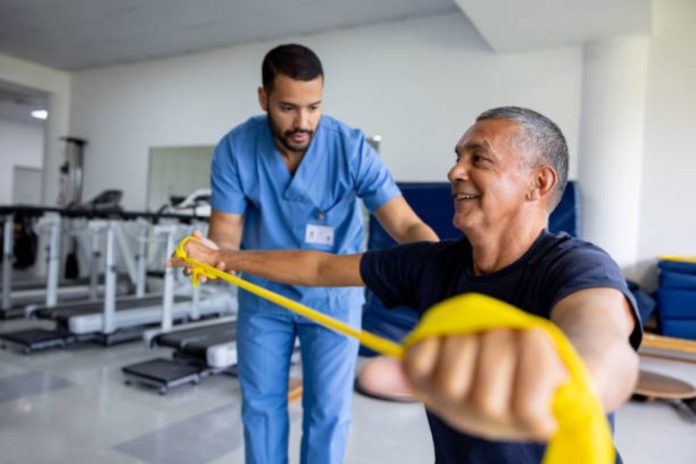Physical therapy has long been a cornerstone of rehabilitation, helping individuals recover from injuries, manage chronic conditions, and improve mobility. However, as technology advances, new tools are emerging to complement traditional methods. One such innovation is shockwave therapy, a non-invasive treatment that has shown remarkable potential in boosting the effectiveness of physical therapy.
But what exactly is shockwave therapy, and how does it work in tandem with physical therapy? Let’s discuss its benefits, applications, and why it’s becoming a game-changer in the world of rehabilitation.
What is Shockwave Therapy?
Shockwave therapy, also known as extracorporeal shockwave therapy (ESWT), uses acoustic waves to deliver targeted energy to affected tissues. Originally developed for breaking down kidney stones, this technology has been adapted to treat musculoskeletal issues, such as tendonitis, plantar fasciitis, and even calcifications in soft tissues.
The therapy works by stimulating blood flow, promoting cell regeneration, and encouraging the natural healing process. It’s particularly useful in cases where the body struggles to heal on its own, making it a perfect companion to physical therapy regimens.
How Does Shockwave Therapy Work?
The procedure is straightforward yet effective. A trained therapist uses a handheld device to emit shockwaves directly onto the affected area. These waves penetrate deep into the tissues, triggering a biological response.
- Increased Blood Flow: Shockwaves stimulate the formation of new blood vessels, enhancing oxygen and nutrient delivery to the damaged area.
- Pain Reduction: The therapy promotes the release of endorphins and inhibits pain receptors, offering immediate relief.
- Tissue Repair: By activating cellular repair mechanisms, shockwave therapy accelerates the recovery of damaged muscles, tendons, and ligaments.
Now, let’s explore how this therapy fits into the broader context of physical rehabilitation.
Why Combine Shockwave Therapy with Physical Therapy?
Combining shockwave therapy with traditional physical therapy offers a synergistic effect that maximizes recovery outcomes. Here’s why this combination is so effective:
1. Faster Recovery
Physical therapy focuses on exercises and techniques that gradually restore strength and mobility. While effective, progress can sometimes be slow, especially in cases of chronic injuries. Shockwave therapy accelerates this process by directly addressing pain and inflammation, allowing patients to engage in physical therapy exercises more effectively.
2. Enhanced Pain Management
Pain is often a significant barrier to consistent participation in physical therapy. Shockwave therapy provides quick pain relief, enabling patients to perform their prescribed exercises without discomfort. This not only speeds up recovery but also boosts patient morale.
3. Stimulating Hard-to-Reach Areas
Some injuries involve deep tissues or areas with limited blood flow. Shockwave therapy can target these challenging spots, providing the stimulation needed for healing that physical therapy alone might not achieve.
What Conditions Can Benefit from This Combination?
Let’s dive into some specific conditions where the integration of shockwave therapy and physical therapy has proven effective:
Chronic Tendonitis
Conditions like Achilles tendonitis or tennis elbow can be stubborn to heal. Shockwave therapy breaks down scar tissue, stimulates tendon repair, and reduces inflammation, making physical therapy exercises more effective.
Plantar Fasciitis
This common foot condition can be debilitating. Shockwave therapy relieves pain and inflammation, while physical therapy focuses on stretching and strengthening the plantar fascia, leading to long-term recovery.
Calcific Shoulder Tendonitis
Calcifications in the shoulder can restrict movement and cause severe pain. Shockwave therapy helps dissolve these deposits, allowing physical therapy to restore range of motion and functionality.
Post-Surgical Rehabilitation
After surgeries like knee replacements or rotator cuff repairs, shockwave therapy can aid in reducing scar tissue and speeding up recovery, complementing the stretching and strengthening exercises prescribed in physical therapy.
The Patient Experience
You might wonder, “What does shockwave therapy feel like?” or “Is it safe?”
What to Expect During a Session
Shockwave therapy sessions typically last 10–20 minutes. While the treatment might feel slightly uncomfortable—often described as a tingling or tapping sensation—it is generally well-tolerated. Most patients notice an improvement in their symptoms after just a few sessions.
Safety and Side Effects
Shockwave therapy is considered safe when performed by trained professionals. Minor side effects like redness, swelling, or mild soreness may occur but usually subside within a day or two.
Real-Life Success Stories
To truly appreciate the potential of shockwave therapy, let’s look at some real-life examples.
- Athletes: Professional athletes often rely on shockwave therapy to recover from overuse injuries quickly. Combined with physical therapy, they’re back in the game faster and stronger.
- Chronic Pain Sufferers: Individuals with long-standing conditions like plantar fasciitis have found relief where other treatments failed.
- Post-Surgery Patients: Many have credited this therapy for smoother recoveries and reduced reliance on pain medications.
Is Shockwave Therapy Right for You?
While shockwave therapy offers numerous benefits, it’s not suitable for everyone. People with certain medical conditions, such as blood clotting disorders or pacemakers, may need to explore alternative treatments.
If you’re considering this therapy, consult with your physical therapist or healthcare provider to determine if it’s the right fit for your specific needs.
The Future of Rehabilitation
As we’ve discussed, shockwave therapy is revolutionizing the field of rehabilitation. By addressing pain, accelerating healing, and complementing traditional physical therapy, it’s helping patients achieve better outcomes in less time.
What’s even more exciting is the potential for further advancements. Research is ongoing to expand its applications and refine its techniques, making it an even more valuable tool in the years to come.
Final Thoughts
In the journey to recovery, every tool that enhances progress is worth considering. Shockwave therapy, with its proven ability to reduce pain, promote healing, and support physical therapy, is undoubtedly one of those tools.
So, if you’re struggling with a persistent injury or looking to boost your rehabilitation efforts, why not explore this innovative approach? Talk to your healthcare provider today and take the next step toward a healthier, pain-free life.
Have you experienced shockwave therapy? Share your thoughts or questions—we’d love to hear from you!









